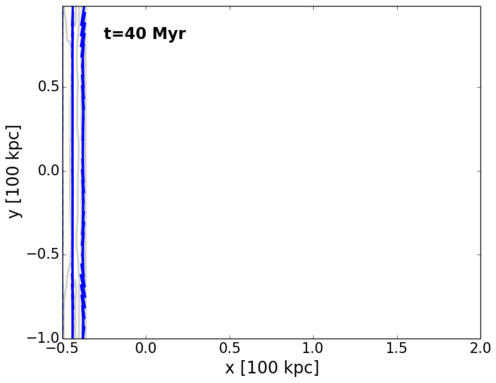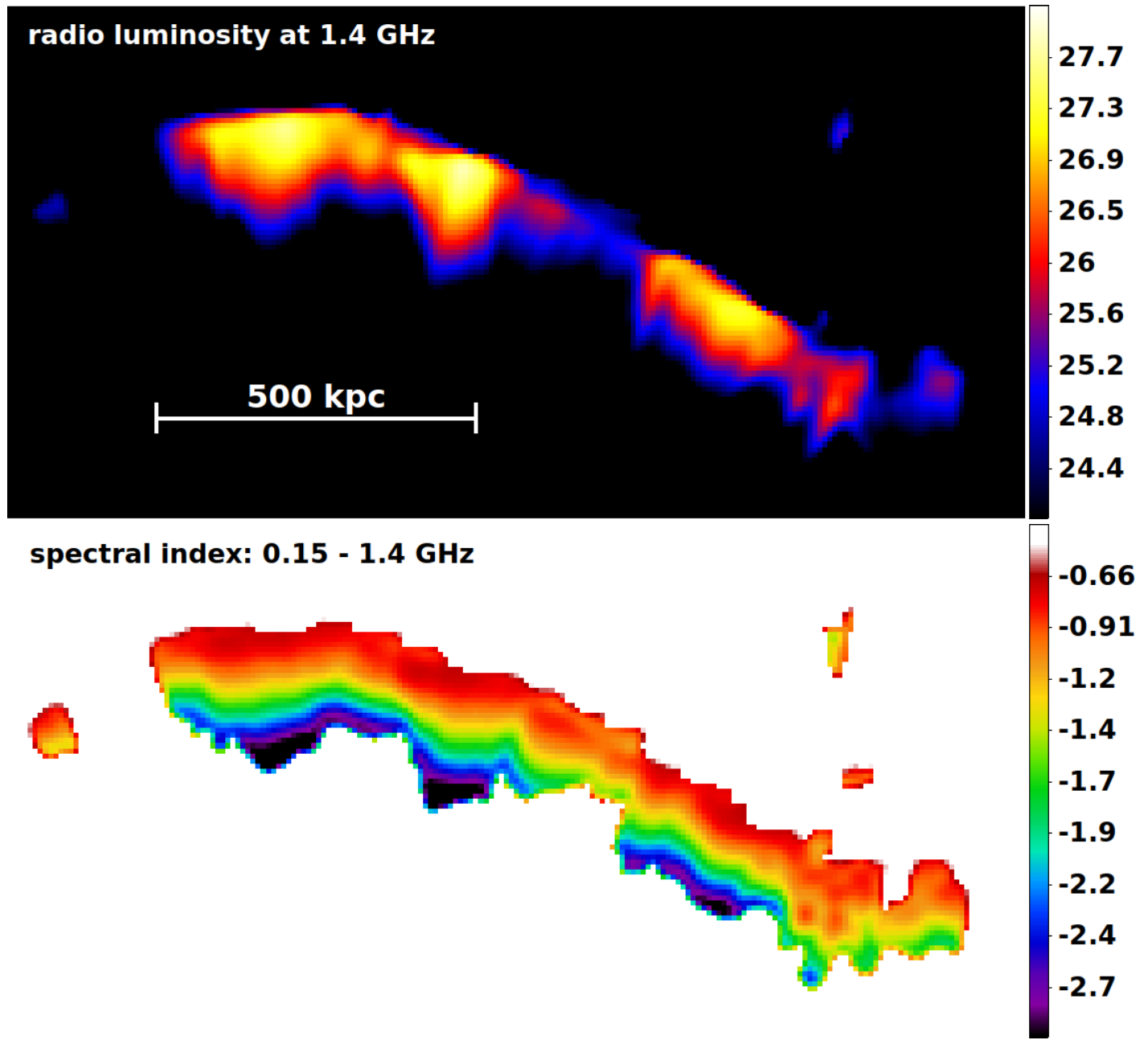My research interests are magnetic fields and theirs signatures in the Universe. Galaxy clusters are an excellent place to study magnetic fields because we can get a hint of their origin plus we get to understand the plasma physics of the intracluster medium. I investigate how magnetic fields evolve in the formation of galaxy clusters and more recently, the radio emission coming from these clusters. Here you can find a brief summary on selected publications.
Morphology of radio relics - II. Properties of polarized emission
P. Domínguez-Fernández, M. Brüggen, F. Vazza, M. Hoeft, W. E. Banda-Barragán, K. Rajpurohit, D. Wittor, A. Mignone, D. Mukherjee, B. Vaidya.
https://doi.org/10.1093/mnras/stab2353

Radio relics are diffuse radio sources in galaxy clusters that are associated with merger shock waves. Detailed observations of radio relics in total intensity and in polarization show complex structures on kiloparsec scales. Using 3D magneto-hydrodynamical simulations, we study the polarized emission produced by a shock wave that propagates through a turbulent medium that resembles the intracluster medium. We model the polarized synchrotron emission on the basis of diffusive shock acceleration of cosmic ray electrons. We find that the synchrotron emission produced in a shocked turbulent medium can reproduce some of the observed features in radio relics. Shock compression can give rise to a high polarization fraction at the shock front and a partial alignment of the polarization E-vectors with the shock normal. Our work confirms that radio relics can also be formed in an environment with a tangled magnetic field.
Morphology of radio relics - I. What causes the substructure of synchrotron emission?
Domínguez-Fernández, P., Bruggen, M., Vazza, F., Banda-Barragan, W. E., Rajpurohit, K., Mignone, A., Mukherjee, D. and Vaidya, B.
https://doi.org/10.1093/mnras/staa3018

We performed 3D magnetohydrodynamical simulations of merger shock waves propagating through a magnetized, turbulent intracluster medium. Our model includes the diffusive shock acceleration (DSA) of cosmic ray electrons, their spatial advection and energy losses at run-time. We find that upstream turbulence plays a major role in shaping the properties of radio relics produced downstream. Within the assumption of DSA, we can reproduce the observed discrepancy between the X-ray derived Mach number of shocks, and the Mach number inferred from radio spectra. Our simulations suggest that radio relics can potentially constrain the distribution of magnetic fields in galaxy clusters outskirts.
Polarisation of Radio Relics in Galaxy Clusters
Wittor, D., Hoeft, M., Vazza, F., Brüggen, and Domínguez-Fernández, P.
https://doi.org/10.1093/mnras/stz2715

Unrelaxed galaxy clusters exhibit a still not well understood radio emission in theirs outskirts that is highly polarised: radio relics. In this work, we test if state-of-the-art high resolution cosmological simulations are able to reproduce the polarisation features of radio relics. We create mock radio observations of the diffuse polarized emission from a massive galaxy cluster using six different projections, frequencies and telescope beam characteristics. We find a degree of polarisation and small-scale structures that resemble observed radio relics. Our simulations also suggest that, due to the effect of Faraday rotation, it is extremely difficult to relate the morphology of the polarised emission for frequencies lower than 1.4 GHz to the real magnetic field structure in relics.
A Song of Shocks and Dynamo: Numerical Studies of a Galaxy Cluster Merger in the HIMAG Project
Wittor, D., Domínguez-Fernández, P., Vazza, F. and Brüggen, M.
https://arxiv.org/abs/1909.10792

In this work, we performed cosmological MHD simulations with the code ENZO that were ran in the Jülich Supercomputer Center. We investigate the evolution of magnetic fields in galaxy clusters and filaments with an unprecedented dynamical range. Our simulations revealed the development of a small-scale dynamo influencing the amplification of magnetic fields. Additionally, various shock waves are created as a consequence of cluster formation and they are able to accelerate existing cosmic-ray electrons and causing them to emit in the radio frequencies. We also incorporate the cooling of electrons in our simulations in a post-processing manner in order to model the radio emission within galaxy clusters.
Dynamical evolution of magnetic fields in the intracluster medium
Domínguez-Fernández, P., Vazza, F., Brüggen, M. and Brunetti, G.
https://doi.org/10.1093/mnras/stz877

In this work, we track the evolution of magnetic fields in a sample of galaxy clusters starting from constant primordial fields using highly resolved cosmological simulations. Our sample shows clear signatures of magnetic field amplification via a small-scale dynamo, we study how the spectral properties of magnetic fields are affected by mergers. Overall, we find that major mergers are found to delay the dynamo action, whereas continuous minor mergers promote its steady growth.
The challenge of detecting intracluster filaments with Faraday Rotation
Locatelli, N., Vazza, F. and Domínguez-Fernández P.
https://doi.org/10.3390/galaxies6040128

The detection of filaments in the cosmic web will be crucial to distinguish between possible magnetogenesis scenarios. In this work, we use numerical simulations of galaxy clusters with a primordial seeding scenario and with a second astrophysical scenario, in which we employed radiative simulations with a simple prescription for feedback from active galactic nuclei (AGN). By computing the Faraday Rotation signal in intracluster filaments we find that the expected big improvement in sensitivity with the SKA-MID will in principle allow the detection of a large fraction of filaments surrounding galaxy clusters. However, the contamination of the intrinsic Faraday Rotation of background polarized sources will represent a big limitation.
On the evolution of inhomogeneities on a Dark Matter halo with the Vlasov equation
Domínguez-Fernández, P., Jiménez-Vázquez, E. and Alcubierre, M.
https://doi.org/10.1007/s10714-017-2286-8

We use a direct numerical integration of the Vlasov equation in spherical symmetry with a background gravitational potential to determine the evolution of a collection of particles in different models of a galactic halo in order to test its stability against perturbations. Non-trivial stationary states are obtained and determined by the virialization of the system. Our study shows that the Navarro-Frenk-White (NFW) halo model is the most stable of the considered models.